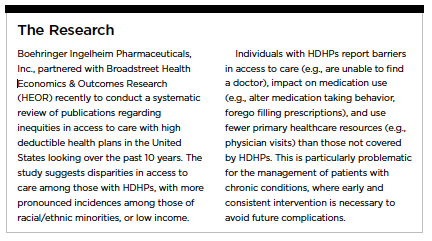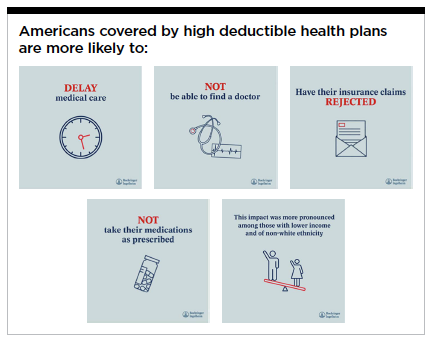 High deductible health plans (HDHPs) were created 20 years ago to foster a more consumer-driven and affordable healthcare landscape. Have they lived up to that vision? While these plans are beneficial for certain populations, new research suggests they may also play a role in broadening the existing racial and ethnic disparities in healthcare, with unintended consequences across our healthcare ecosystem.
High deductible health plans (HDHPs) were created 20 years ago to foster a more consumer-driven and affordable healthcare landscape. Have they lived up to that vision? While these plans are beneficial for certain populations, new research suggests they may also play a role in broadening the existing racial and ethnic disparities in healthcare, with unintended consequences across our healthcare ecosystem.
Healthcare for all?
HDHPs have steadily increased in popularity since their introduction and are currently used by 30-50%  of insured Americans. The attraction is compelling: lower monthly premiums, often with health savings accounts (HSAs) to cover out-of-pocket expenses for doctor visits, medications, treatments, etc. It’s a system that works particularly well for young, healthy individuals who aren’t expected to need significant healthcare services.
of insured Americans. The attraction is compelling: lower monthly premiums, often with health savings accounts (HSAs) to cover out-of-pocket expenses for doctor visits, medications, treatments, etc. It’s a system that works particularly well for young, healthy individuals who aren’t expected to need significant healthcare services.
To understand whether HDHPs are working efficiently across diverse communities, Boehringer Ingelheim Pharmaceuticals, Inc. partnered with Broadstreet Health Economics & Outcomes Research (HEOR) to conduct a review of published evidence regarding the impact of HDHPs on access to care and healthcare resource use (HCRU) over the past 10 years. The findings show a consistent trend of patients reporting more challenges obtaining care, and less frequent use of preventive and primary healthcare if they were on HDHPs — with mounting evidence of a disproportionate impact on non-white and/or low-income individuals and families.
Financial burden directly impacts healthcare choices
The importance of accessing the right care at the right time to avoid serious complications has been documented in many therapeutic areas. In the context of HDHPs, this needs to be reconciled with the recognition that individuals will choose to sacrifice preventive and maintenance care if they have financial concerns.
Despite the lower monthly premiums of HDHPs, the magnitude of OOP costs, and their steadily increasing thresholds over time, can still mean substantial healthcare expenses for HDHP participants — particularly those with chronic conditions. For an  individual with diabetes, for example, necessary chronic medication and doctor visits can lead to overwhelming costs before satisfying deductibles. Consequently, many choose to delay or avoid necessary healthcare, leading to unintended consequences such as poorer health outcomes and an increased use of hospitals as primary care resources. In fact, the review uncovered a variety of sub-optimal health-related behaviors driven by financial issues for those on HDHPs, particularly those who are of lower income or who belong to racial/ethnic minorities.
individual with diabetes, for example, necessary chronic medication and doctor visits can lead to overwhelming costs before satisfying deductibles. Consequently, many choose to delay or avoid necessary healthcare, leading to unintended consequences such as poorer health outcomes and an increased use of hospitals as primary care resources. In fact, the review uncovered a variety of sub-optimal health-related behaviors driven by financial issues for those on HDHPs, particularly those who are of lower income or who belong to racial/ethnic minorities.
There is evidence of racial and income-related disparities in the frequency of patients changing their medication taking behavior due to cost. This includes skipping, taking less, or delaying filling prescriptions to save money — behaviors more pronounced among minority groups.
Individuals from lower income families tend to report more problems affording ongoing care, and reduced use of primary and specialty care, along with higher use of emergency rooms (ER) and hospitals.
Many lower-income patients with high healthcare cost burdens report needing to use varied cost-savings strategies to finance their health care. They also spend a higher percentage of household/disposable income to fund their OOP costs and have a higher likelihood of experiencing debt due to medical costs.
The impact of high OOP costs to medication adherence, access to care, and individual finances speaks to the widespread ramifications of HDHPs – not just to patients, but to families and the greater economy.
Solutions are grounded in education and counseling
The learnings around HDHPs demand careful consideration for each vested audience in the healthcare community.
For plan enrollees. Pharma can be a resource for plans and employee groups by sharing their expertise around treatment and the impact of treatment on cost of care.  This might include providing counseling materials so that individuals clearly understand the personal impact of HDHPs given their health history, especially for those with chronic conditions. It’s important to encourage employees to think about the current health-related needs for each member of their family who will be covered by the plan, not just their own health status. This should also include considerations for future potential health needs, beyond those just anticipated within the plan year.
This might include providing counseling materials so that individuals clearly understand the personal impact of HDHPs given their health history, especially for those with chronic conditions. It’s important to encourage employees to think about the current health-related needs for each member of their family who will be covered by the plan, not just their own health status. This should also include considerations for future potential health needs, beyond those just anticipated within the plan year.
For employers. Companies have a vested interest in choosing plans that support their employees’ appropriate and necessary use of healthcare, so their workforce remains healthy and productive, with sick days at a minimum, while cognizant of a vector of financial considerations. It’s beneficial to ensure that employees are educated about the available plan types to ensure they make optimal choices for their personal situation (whether individual or family), even when the financial implications override the health care situation or needs. It’s also important to acknowledge that health plan selection occurs annually (unless allowed personal changes warrant differently) – but health status can change at any time.
For payers. Ultimately, the goal for an insurance provider is to provide coverage choices that support a healthy lifestyle for their subscribers and families. Data from the recent BI/Broadstreet HEOR review identifies potential areas where payers can provide critical data and tools to assist individuals to select plans to ensure the most efficient use of healthcare resources now — as well as account for potential implications downstream that should inform their choices.
Self-reported assessment tools that document health status and risk factors for future health events can provide much-needed help in guiding choice of a health plan. It could be as simple as flagging key information for individuals who need to manage chronic conditions: if you have a family history of a chronic condition, what’s the right decision for your future potential health? Or, perhaps it’s creating a simple calculator to provide more accurate estimates of annual costs for an individual or family health situation.
Future research is needed
Given the widespread use of HDHPs, clearly more work needs to be done to understand the impact of these plans for non-white communities, low-income households, and individuals/family members with chronic conditions. Future research should also examine the decision-making process in choosing a plan (especially where employers provide choices), patient satisfaction over time, and whether use of HDHPs changes in times of financial hardship. Once we have answers to these provocative questions, we can work together to develop solutions that are sustainable and effective in helping advance positive health outcomes for all.(PV)
~~~~~~~~~~~~~~~~~~~~~~~~~
The Research
Boehringer Ingelheim Pharmaceuticals, Inc., partnered with Broadstreet Health Economics & Outcomes Research (HEOR) recently to conduct a systematic review of publications regarding inequities in access to care with high deductible health plans in the United States looking over the past 10 years. The study suggests disparities in access to care among those with HDHPs, with more pronounced incidences among those of racial/ethnic minorities, or low income.
Individuals with HDHPs report barriers in access to care (e.g., are unable to find a doctor), impact on medication use (e.g., alter medication taking behavior, forego filling prescriptions), and use fewer primary healthcare resources (e.g., physician visits) than those not covered by HDHPs. This is particularly problematic for the management of patients with chronic conditions, where early and consistent intervention is necessary to avoid future complications.
Boehringer Ingelheim Pharmaceuticals, Inc., is working on breakthrough therapies that improve the lives of humans and animals. As a leading research-driven biopharmaceutical company, the company creates value through innovation in areas of high unmet medical need.
For more information, visit
boehringer-ingelheim.us.
Broadstreet Health Economics & Outcomes Research (HEOR) creates custom, evidence-based solutions for value and access questions across a drug product life cycle, delivered with novel, elegant data visualizations.
For more information, visit
broadstreetheor.com.



















